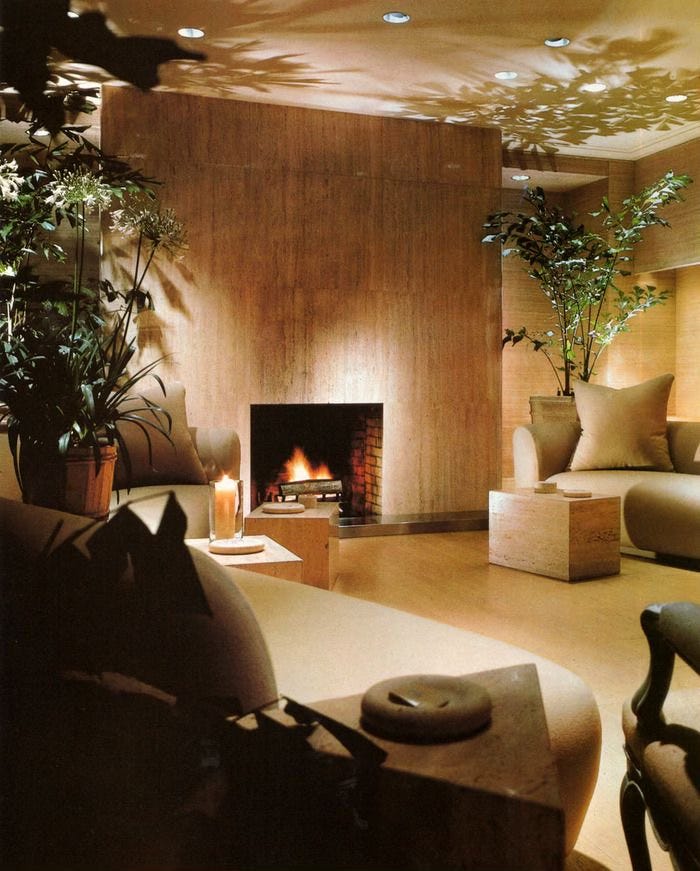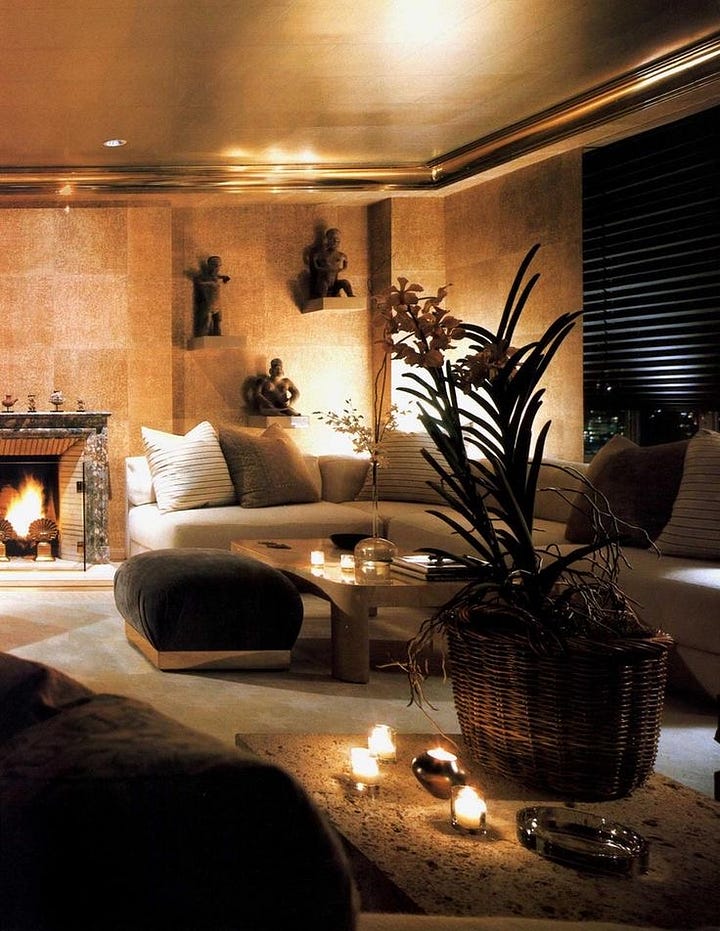
So much of our intimate, private lives are lived at home under the night sky. And yet, storytelling in design books, magazines and social media today all seem to avoid these narrative-rich hours to focus almost solely on photographing interiors in daylight. Why is that? This was not always the case.
For much of the 20th century, interiors photography embraced the beauty of capturing evenings, often playing with light and shadow to create dramatic nighttime imagery, illuminating the senses with highs and lows for graphic impact.


Art direction for interiors photography in the 1970s and 80s was a response to the designers of the day, who envisioned homes with glamorous appeal, often utilizing reflective materials such as mirrored walls, high polish brass and lacquer, metallic blinds, and translucent glass blocks for maximal shimmer. The appeal of disco culture on the arts permeated into interior design, evidenced by the prevalent use of spotlights and up-lights at the time to create a nightlife mood that chic people desired for their homes. Be it modern or traditional decorating, across party lines designers wanted to party, long before quiet luxury became the definition of so-called good taste.
This nocturnal chic aesthetic for interiors photography had a lasting influence that far outlived disco, becoming a standard practice look for decades to follow. But as the design administration of the late 1990s prepared for the millennium, an intentional shift in sensibility away from evening shoots in favor of natural daylight became editorial code for what's new, what's next. With the 21st century on the horizon, design world decision makers turned their backs on evening photography, ushering in an evenly lit, shadowless aesthetic. This endless summer feeling has been the dominate image standard for design media ever since.
One can point to several major factors for shifting taste for art direction at the end of the 20th century, including the technical switch from analog film medium to digital photography at that time, advancements in retouching technology, as well as a new crop of home brands entering the design space with a light and airy vision for the future.
One brand that stands out in my memory for its impact on changing taste in lighting is Calvin Klein, which entered the home category in 1995. As Klein’s minimalist point of view reached its apex during the 90s, its style influence carried into consumer-facing home products. Ads for Calvin Klein Home Collection were mainstays of magazines through the millennium, always front-of-book, often featuring bedrooms in even daylight. Suddenly, up-lighting rooms to cast dramatic silhouettes of palm fronds on ceilings felt out of fashion.
By Y2K, a new generation of 21st century designers and editors understood the assignment: To be fresh meant turning the lights off and letting daylight in. Cut to design media today, some three decades later, and one will not easily find editorials of contemporary interiors photographed at night. It’s a fascinating run to think about. There are still no major design magazines presenting home stories entirely in evening light.
It is with this thinking, that I recently started an image archive on Instagram called Evenings Magazine. The point of Evenings Magazine project is to investigate the editorial merits of shooting interiors as they evolve with light, from day to dusk to night. It is an archive to honor iconic projects from the past, in hopes to encourage a future for interiors photography that once again documents homes in the evening, arguably one of the most personal, if not most exciting hours of living in our homes.
Thinking for living,
Sean
Brand Utility
Consider art direction that revolves around the moon rather than the sun. Push the status quo.
Do a nighttime scout of your space to see if it’s compelling at night. Many homes are.
If you have a project that isn’t naturally light-filled, lean into the opportunities of a dramatic lighting plan, rather than fighting against the natural state of the home.
Could shooting interiors through the lens of evening photography cut through the monotony of the current feed?
A new generation of interiors photographers such as Yoshi Makino and William Jess Laird are forerunners experimenting with evening interiors photography today.
Shoot your project while hosting a cocktail party. Activating spaces with people is an underdeveloped and undervalued ingredient for interiors photography. Consider the opportunities of this overlay.
Why not shoot a project two ways, day and night, to tell two different stories about your design.









It’s fun when a project demands the night shoot… it’s a hard turn to NOT shoot a glamorous dining room that is obviously ONLY designed for the evening hours… and still when done both ways they run the dead unsettled dining room vs the vavavoom shots the photog will include in their book later (maybe)
Bravo, Sean. We have all suffered through the editorial straight jacket of having to shoot rooms designed purely for nighttime living and entertaining with the lights off, with lackluster results. Having started my career in the 80's and having worked with the great Jaime Ardiles-Arce, I long for a great nighttime shoot. Every recessed light is now deleted from the published page, making nonsensical images and distorting reality. Many rooms, if not entire interiors, are conceived for the dark and I hope your campaign finds it's wings so they can be celebrated.